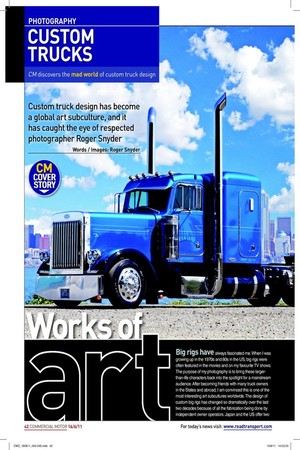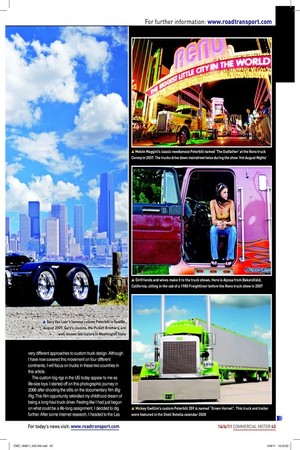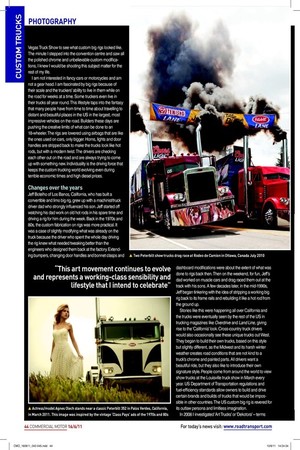Works of
Page 37

Page 38

Page 39

Page 40

If you've noticed an error in this article please click here to report it so we can fix it.
Big rigs have always fascinated me. When I was growing up in the 1970s and 80s in the US, big rigs were often featured in the movies and on my favourite TV shows. The purpose of my photography is to bring these largerthan-life characters back into the spotlight for a mainstream audience. After becoming friends with many truck owners in the States and abroad, I am convinced this is one of the most interesting art subcultures worldwide. The design of custom big rigs has changed so dramatically over the last two decades because of all the fabrication being done by independent owner operators. Japan and the US offer two very different approaches to custom truck design. Although I have now covered this movement on four different continents, I will focus on trucks in these two countries in this article.
The custom big rigs in the US today appear to me as life-size toys. I started off on this photographic journey in 2006 after shooting the stills on the documentary film Big Rig. This film opportunity rekindled my childhood dream of being a long-haul truck driver. Feeling like I had just begun on what could be a life-long assignment, I decided to dig further. After some internet research, I headed to the Las Vegas Truck Show to see what custom big rigs looked like. The minute I stepped into the convention centre and saw all the polished chrome and unbelievable custom modifications, I knew I would be shooting this subject matter for the rest of my life.
I am not interested in fancy cars or motorcycles and am not a gear head. I am fascinated by big rigs because of their scale and the truckers’ ability to live in them while on the road for weeks at a time. Some truckers even live in their trucks all year round. This lifestyle taps into the fantasy that many people have from time to time about travelling to distant and beautiful places in the US in the largest, most impressive vehicles on the road. Builders these days are pushing the creative limits of what can be done to an 18-wheeler. The rigs are lowered using airbags that are like the ones used on cars, only bigger. Horns, lights and door handles are stripped back to make the trucks look like hot rods, but with a modern twist. The drivers are checking each other out on the road and are always trying to come up with something new. Individuality is the driving force that keeps the custom trucking world evolving even during terrible economic times and high diesel prices.
Changes over the years
Jeff Botelho of Los Banos, California, who has built a convertible and limo big rig, grew up with a machinist/truck driver dad who strongly influenced his son. Jeff started off watching his dad work on old hot rods in his spare time and driving a rig for him during the week. Back in the 1970s and 80s, the custom fabrication on rigs was more practical. It was a case of slightly modifying what was already on the truck because the driver who spent the whole day driving the rig knew what needed tweaking better than the engineers who designed them back at the factory. Extending bumpers, changing door handles and bonnet clasps and dashboard modifications were about the extent of what was done to rigs back then. Then on the weekend, for fun, Jeff’s dad worked on muscle cars and drag raced them out at the track with his sons. A few decades later, in the mid-1990s, Jeff began tinkering with the idea of stripping a working big rig back to its frame rails and rebuilding it like a hot rod from the ground up.
Stories like this were happening all over California and the trucks were eventually seen by the rest of the US in trucking magazines like Overdrive and Land Line, giving rise to the ‘California’ look. Cross-country truck drivers would also occasionally see these unique trucks out West. They began to build their own trucks, based on this style but slightly different, as the Midwest and its harsh winter weather creates road conditions that are not kind to a truck’s chrome and painted parts. All drivers want a beautiful ride, but they also like to introduce their own signature style. People come from around the world to view show trucks at the Louisville truck show in March every year. US Department of Transportation regulations and fuel-efficiency standards allow owners to build and drive certain brands and builds of trucks that would be impossible in other countries. The US custom big rig is revered for its outlaw persona and limitless imagination.
In 2008 I investigated ‘Art Trucks’ or ‘Dekotora’ – terms used to describe the custom truck scene in Japan. The movement really took off in the late 1970s after a movie similar to America’s Convoy came out, called Truck Yaro. The movie has a simple plot and stars Bunta Sugawara, the top movie star in Japan of the decade. The film kicked off a truck design boom that flourishes today, even in Japan’s depressed economy.
Eastern designs
The evolution of the Japanese trucks’ designs has been truly remarkable. At first, leftover parts from US military planes, ships and trucks were used to customise the trucks, much like those in the Philippines, known as ‘Jeepneys’. After Japanese fabricating shops started bending stainless steel, painting elaborate murals and rigging lights, the trucks took on a futuristic look never seen before. The light shows put on by the trucks need to be experienced in person. The shows are synchronised with Japanese pop music that blares from hidden speakers mounted in the trucks’ grilles. The power drain is so great that external generators are camouflaged around the sides of the trucks and cranked up to support the show. These shows are an audiovisual spectacle unlike any other in the world.
Japanese custom truckers generally participate in four or five shows a year, depending on the economy. The shows are usually held in remote areas, typically on a raw fairground space that requires ground levelling and excavation to allow the trucks to drive and park on a level surface. In addition to preparing the track and parking area, the participants collaborate to build vendor stands that sell food and collectable toy trucks and other gifts. The show I have attended several times, in the Aichi prefecture, is a fundraiser for disadvantaged children that falls on the last day of the national holiday ‘Golden Week’, around the last week of April/beginning of May. This is an occasion for the drivers to bring their families and spend a weekend together, using the big rig as a camper and socialising with other art truck owners. Like any art movement, the drivers take inspiration from each other’s trucks and are always attempting to have the most unique ride on the road. All around the world you will find big rigs hauling everything we consume. In this large group of vehicles you will come across a select few drivers who custom-build their rides in an artistic fashion. This art movement continues to evolve and represents a workingclass sensibility and lifestyle that I intend to celebrate by meeting up with these special truckers and photographing these works of art whenever I get the opportunity.
I hope people never look at a big rig the same after seeing my photos. ■














































